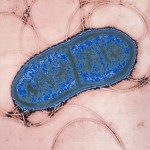Link to Pubmed [PMID] – 26755632
J Bacteriol. 2016 Jan 11. pii: JB.00897-15
Clustered regularly interspaced short palindromic repeat (CRISPR) loci encode an adaptive immune system of prokaryotes. Within these loci, sequences intercalated between repeats known as “spacers” specify the targets of CRISPR immunity. The majority of spacers match sequences present in phages and plasmids, however it is not known whether there are differences in the immunity provided against these diverse invaders. We studied this question using the Staphylococcus epidermidis CRISPR system, which harbors spacers matching both phages and plasmids. We determined that this CRISPR system provides similar levels of defense against both the conjugative plasmid pG0400 and the bacteriophage CNPX. However, whereas anti-plasmid immunity was very sensitive to the introduction of mismatches in the target sequence, mutations in the phage target were largely tolerated. Placing the phage and plasmid targets into a vector that can be both conjugated and transduced, we demonstrate that the route of entry of the target has no impact on the effect of the target mismatches on immunity. Instead, we established that the specific sequences of each spacer/target determines the susceptibility of the S. epidermidis CRISPR system to mutations. Therefore spacers that are more resistant to mismatches would provide long-term immunity against phages and plasmids that otherwise will escape CRISPR targeting through the accumulation of mutations in the target sequence. These results uncover an unexpected complexity in the arms race between CRISPR-Cas systems and prokaryotic infectious genetic elements.
IMPORTANCE:
CRISPR-Cas loci protect bacteria and archaea from both phage infection and plasmid invasion. These loci harbor short sequences of phage and plasmid origin known as “spacers” that specify the targets of CRISPR-Cas immunity. The presence of a spacer sequence matching a phage or plasmid ensures host immunity to the infection by these genetic elements. In turn, phages and plasmids constantly mutate their targets to avoid recognition by the spacers of the CRISPR-Cas immune system. In this study we identify that different spacer sequences vary in their ability to tolerate target mutations that allow phages and plasmids to escape from CRISPR-Cas immunity. These results uncover an unexpected complexity in the arms race between CRISPR-Cas systems and prokaryotic infectious genetic elements.
